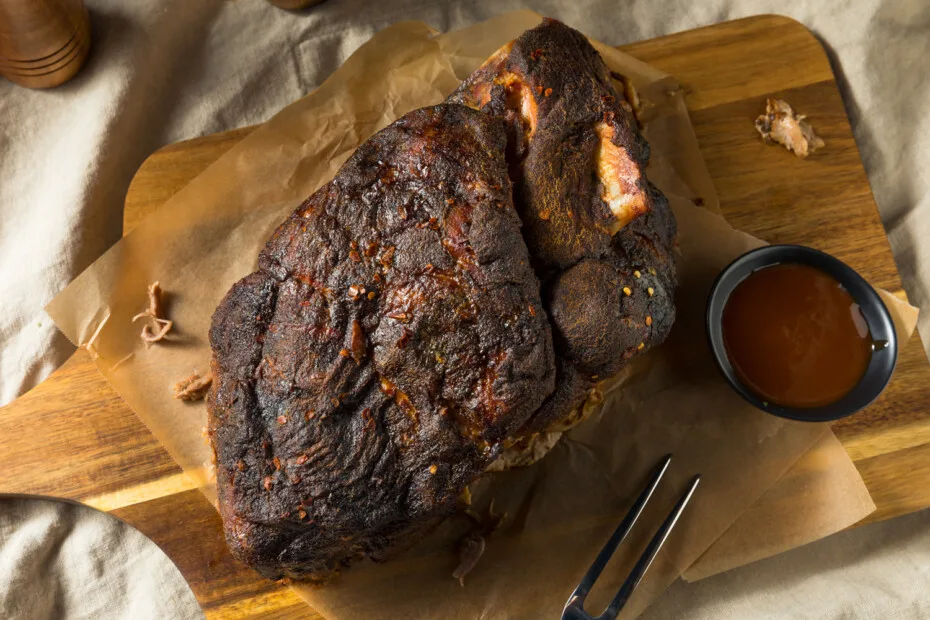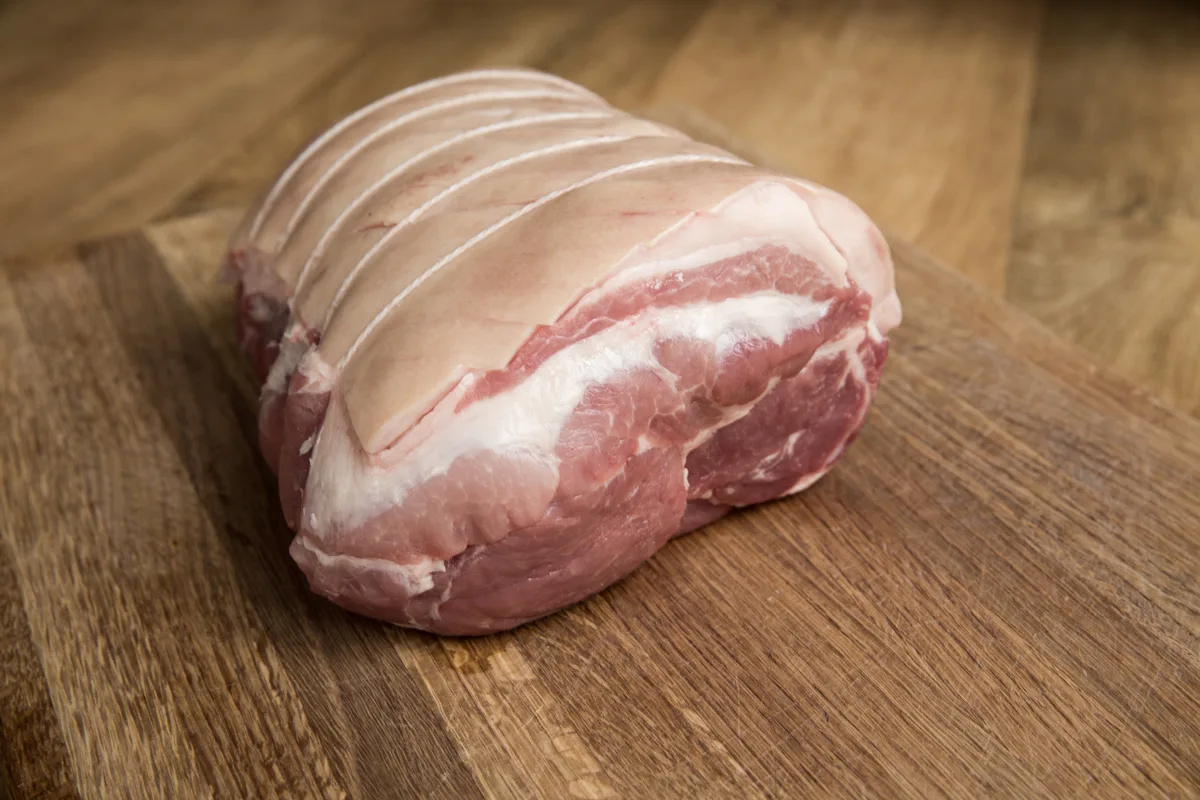If you consider yourself the grill master or are vying for the proud title of pitmaster among your inner circle, the ultimate challenge has to be smoking a perfect pork shoulder.
It is all about grit, patience, temperament, and, yes, of course, controlling your smoker or grill at the right temperature for the entire process.
So, what exactly should that temperature be, and how long will it take?
We will explore how to go low and slow for the juiciest, most tender inside, and the most intensely flavored crusty bark of the notorious pork shoulder.
Contents
- How Long to Smoke Pork Shoulder at 250 Degrees Fahrenheit?
- Choosing Your Pork Shoulder
- Preparing Your Pork Shoulder
- Placing Your Pork Shoulder Into the Smoker
- Smoking Your Pork Shoulder
- Should You Wrap You Pork Shoulder in Foil?
- Preventing Your Pork Shoulder From Overcooking
- Resting and Serving Your Smoked Pork Shoulder
- Final Thoughts
How Long to Smoke Pork Shoulder at 250 Degrees Fahrenheit?
Pork shoulder is a complex cut of meat with a high fat to meat ratio. When the perfect temperature is applied to it, the flavor becomes a meat lover’s dream come true.
After some experimentation, smoked or grilled pork shoulder seems to cook best at 250 degrees Fahrenheit.
At this temperature, it takes about an hour and 30 minutes for the meat to cook through.
This type of low and slow cooking breaks down the fat and connective tissue at just the right pace to maintain the shoulder’s moisture while creating that crispy bark on the outside.
Depending on the weight of the pork shoulder and using 90 minutes as a guideline, allow the pork shoulder to smoke for as long as required.
A best way to check if your pork shoulder has cooked through entirely is by checking its internal temperature.
When the internal temperature reaches 185 to 205 degrees Fahrenheit, your pork should be ready to remove for resting.
At this point, your pork shoulder should be intensely flavorful with a dark brown crusty bark. Allow the meat to rest for up to one hour before slicing or pulling.

Choosing Your Pork Shoulder
If you are new to the world of smoking a pork shoulder, understanding the different cuts is always a good starting point.
But before we get into that, know that pork shoulder can be a scary cut of meat. It is a large fatty chunk of meat and sometimes comes with its skin on.
It also has plenty of connective tissue running through it. But don’t fear because all of this ends up being a succulent, flavorful meat feast that nothing else can deliver.
So, when you are shopping for pork shoulder, you will typically get two cuts – pork butt or picnic shoulder.
The pork butt is also commonly known as the Boston butt.
The pork butt and picnic shoulder come from one cut known as the pork shoulder, therefore, they are similar in flavor and texture.
The pork butt is the more popular cut because it is fattier and has less connective tissue making it perfect for slow cooking at low temperatures.
The picnic shoulder can produce the same results but may take a bit longer to cook.
They are easy to identify, though, because the pork butt is usually a square piece of meat, sold skinless and with the bone in.
The picnic shoulder is triangular and usually comes with its skin on. The skin renders well when cooked low and slow to form the most delicious crispy crust.
Preparing Your Pork Shoulder
Don’t underestimate the preparation phase, as this can be quite time-consuming. But it is absolutely necessary to ensure maximum flavor.
Pork shoulder is quite forgiving when cooked low and slow, so whether you trim the fat or score your meat, the final result can turn out quite similar or mostly more than acceptable.
I do, however, find that if the pork shoulder has a thick fat cap, trimming and scoring the top does allow the spices or marinade to penetrate the meat much easier.
It also makes for a great look post being smoked.
The easiest and most common way to season your pork shoulder for maximum flavor is a technique called rub and mop. To do this:
- Place your pork shoulder on a roasting tray
- Rub the entire pork shoulder with a mixture of oil and mustard or either, depending on the taste you are going for. This will also help with getting the dry rub to stick to the meat
- Sprinkle the dry rub generously to cover the whole shoulder. Patting the rub into the meat makes sure it sticks and is well coated
- Place the tray into the fridge overnight and remove about an hour before smoking
- Create your mop sauce using one part apple cider vinegar, one part apple juice, and one part water or cooking oil. You only need to start mop basting the shoulder after the first hour in the smoker.
If you are feeling adventurous, you can also try a recipe that includes brining or injecting the shoulder. Some will even try all three at once to get maximum flavor and moisture.
Placing Your Pork Shoulder Into the Smoker
Yes, this is a thing. The shoulder should be placed with the fat side facing up.
As the fat renders, it is absorbed by the meat retaining all that flavorful goodness.
It also helps ensure that meat cooks evenly and helps baste the meat with its own natural fat and juices.
Smoking Your Pork Shoulder
The first step is to preheat your smoker to 250 degrees Fahrenheit.
The best wood combination for smoking pork shoulder is hickory with sweeter fruit woods such as apple, cherry, peach, pear, etc.
Next, you need to insert a meat thermometer into the thickest part of your shoulder.
While the general rule is to allow 1.5 hours per pound of cooking time, you are aiming for 185 degrees Fahrenheit if you plan on serving it as slices.
If you are going for pulled pork, then the ideal internal temperature should be 195 to 205 degrees Fahrenheit.
In order to keep the meat moist, mop the shoulder after the first hour in the smoker and thereafter every hour until it is fully cooked.
Should You Wrap You Pork Shoulder in Foil?
Smoking your pork shoulder directly in the pit produces a firm crusty bark with a tender juicy inside when it reaches the prescribed internal temperature.
Wrapping the pork shoulder in foil after it has smoked for a minimum of four hours is said to produce excellent flavor and texture.
At this point, you stop getting any more smoke into the meat’s flavor.
An advantage of wrapping the shoulder in foil is that you can control the moisture a lot better.
I guess the best way to figure out the flavor and texture that suits you best is to experiment.
Preventing Your Pork Shoulder From Overcooking
Contrary to popular belief, low and slow does not mean dumping the meat into the smoker and leaving until your guided time is reached or, even worst, until the heat dies off.
You need to monitor its internal temperature because once the meat reaches 205 degrees Fahrenheit, it will start drying out.
While a good dark, crusty bark is what you should be aiming for, there is a fine line between achieving this or ending up with a charred dry pork disaster.
There is one other thing that you should be aware of while smoking your pork shoulder, and that is something called the stall phase.
During this phase of the smoking process, the internal temperature will stall at about 150 to 170 degrees Fahrenheit.
The reason for this is because the fat and collagen are liquifying at this point which slows down the temperature.
While there are some hacks to speed up the stall phase, experienced pitmasters recommend that you wait it out, as getting to a crispy bark is what you are really after.
Resting and Serving Your Smoked Pork Shoulder
Once your pork shoulder has reached 185 to 205 degrees Fahrenheit, it is time to give the shoulder a good old rest.
The shoulder should be left to rest for at least one hour before you slice or pull it.
To slice the pork shoulder, make a downward wedge on the shoulder by slicing away from the shank.
Continue slicing thick slices at the same angle until you have gone through the whole shoulder.
To pull your pork, use a shredding tool to pull the strands. This will ensure that you maintain the texture.
My favorite pork shoulder meal is the scrumptious meat with are garlic cauliflower mash, fried cabbage with bacon, onion, and garlic, or a light fruity salad.
But I know that pulled pork sandwiches with the works on or pulled pork tacos are also great crowd-pleasers.
Final Thoughts
While some pitmasters, grill masters, or apprentices prefer smoking pork shoulder at 200-, 225- or 275-degrees Fahrenheit, experience has taught us that 250 degrees Fahrenheit works well and presents the least amount of risk to an over charred dry pork shoulder.
We have also learned that it is not the temperature of the smoker alone that determines the outcome.
Seasoning the shoulder well, basting it every hour, and most importantly, removing it from the smoker once the internal temperature reaches 185 to 205 degrees Fahrenheit ultimately determines that crusty outside bark and succulent inside.

I have been smoking and grilling meat from an early age and enjoy sharing my knowledge and expertise through the hundreds of articles I have written about BBQ. I hope to make everyone’s BBQ journey that little bit easier.

